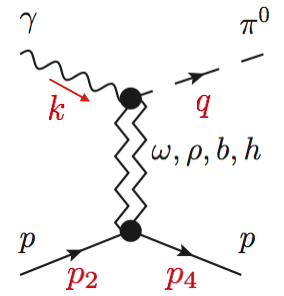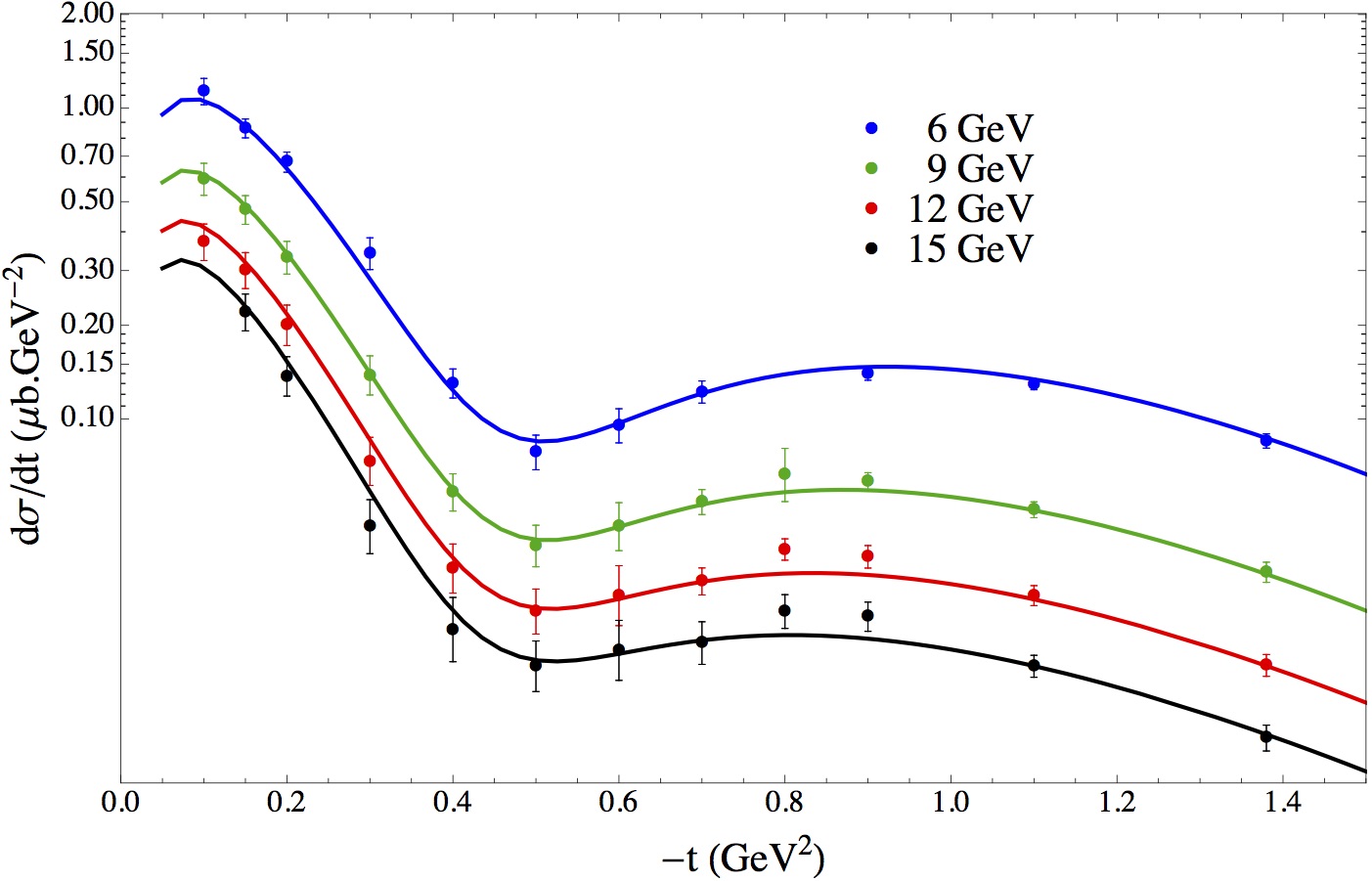 We present the model published in [Mat15a] .
We present the model published in [Mat15a] .
The differential cross section for $\gamma p\to\pi^0 p$ is computed with Regge amplitudes in the
domain $E_\gamma\ge 4$ GeV and $0.01\le |t| \le 3$ (in GeV$^2$).
The formulas can be extrapolated outside these intervals.
We use the CGLN invariant amplitudes $A_i$ defined in [Chew57a].
See the section Formalism for the definition of the variables.
The fitting procedure is detailed in [Mat15a] .
We report here only the main features of the model.
Formalism
The differential cross section is a function of 2 variables.
The first is the beam energy in the laboratory frame $E_\gamma$ (in GeV)
or the total energy squared $s$ (in GeV$^2$). The second is the cosine
of the scattering angle in the rest frame $\cos\theta$ or
the momentum transfered squared $t$ (in GeV$^2$).
The momenta of the particles are $k$ (photon), $q$ (pion), $p_2$ (target) and $p_4$ (recoil).
The pion mass is $\mu$ and the proton mass is $M$.
The Mandelstam variables, $s=(k+p_2)^2$, $t=(k-q)^2$, $u=(k-p_4)^2$ are related through $s+t+u=2M^2+\mu^2$.
The differential cross section is expressed in term of the parity conserving helicity invariant amplitudes in the $t-$channel $F_i$
\begin{align}\nonumber
\frac{d\sigma}{dt} = \frac{389.4}{64\pi} \frac{k_t^2}{4 M^2 E_\gamma^2}
\left[ 2\sin^2\theta_t \left( t |F_1|^2 +4 p_t^2 |F_2|^2 \right)
+ (1-\cos\theta_t)^2 \left| F_3+2\sqrt{t} p_t F_4\right|^2
+ (1+\cos\theta_t)^2 \left| F_3-2\sqrt{t} p_t F_4\right|^2 \right]
\end{align}
The differential cross section is expressed in $\mu$b/GeV$^2$.
We used $(\hbar c)^2=0.3894$ mb.GeV$^2$.
The $t-$channel is the rest frame of the process $\gamma \pi^0 \to p\bar p$.
In the $t-$channel, the momenta of the nucleon $p_t$ and the pion $k_t$ and
the cosine of the scattering angle are
\begin{align}
k_t & = \frac{1}{2}\sqrt{t-4M^2}, & q_t&= \frac{t-\mu^2}{2\sqrt{t}},
& \cos\theta_t &= \frac{s-u}{4 p_t k_t}.
\end{align}
The invariant amplitudes $F_i$ are related through the CGLN $A_i$ amplitudes
[Chew57a] by
\begin{align} \label{eq:F1}
F_1&= -A_1+2MA_4,& \eta &= +, & CP&=+\\
F_2&= A_1+t A_2 ,& \eta &= -, & CP&=-\\
F_3&= 2M A_1-t A_4,& \eta &= +, & CP&=+\\ \label{eq:F4}
F_4 &=A_3& \eta &= -, & CP&=+\\
\end{align}
The $F_i$ amplitudes have good quantum numbers of the $t-$channel, the naturality $\eta=P(-1)^J$
and the product $CP$.
$C$ and $P$ are the charge conjugation and the parity. $J$ is the total spin.
Model
The model is based on the exchange of the leading Regge singularities.
Since $C(\gamma\pi^0) = -\gamma\pi^0$, the only quantum numbers allowed in the $t-$channel are
\begin{align}
\rho &: I^{G\tau\eta}=1^{+-+}, & F_1,F_3\\
\omega &: I^{G\tau\eta}=0^{--+}, & F_1,F_3\\
b &: I^{G\tau\eta}=1^{+--}, & F_2\\
h &: I^{G\tau\eta}=0^{---}, & F_2\\
\end{align}
The second column indicates the amplitudes which the exchange contributes to.
$G=C(-1)^I$ is the $G-$parity and $\tau=(-1)^J$ is the signature.
The quantum numbers of the trajectories are denoted by the lowest spin particles.
Our model is insensitive to the isospin. We will refer to vector for the $\rho$ and $\omega$ trajectories and to axial-vector for the $b$ and $h$ trajectories.
The $t$ dependence of the amplitudes is determined by matching the exchange of the lowest particles in the CGLN basis. The amplitudes involve the vector ($\alpha_V$) and axial-vector ($\alpha_A$) poles but also the vector cut ($\alpha_c$) trajectories
\begin{align} \label{eq:F1Reg}
F_1 &= (-g_1 t+2Mg_4) R(\alpha_V) + (-g^c_1 t+2Mg^c_4) R_c(\alpha_c) ,\\
F_2&= g_2 t R(\alpha_A),\\
F_3&= (2M g_1 - g_4) t R(\alpha_V) + (2M g^c_1 - g^c_4) t R_c(\alpha_c),\\ \label{eq:F4Reg}
F_4 &=0.
\end{align}
The $g_i$ are real parameters, the couplings.
The energy dependence is given by the Regge prescription (with $s_0=1$ GeV$^2$)
\begin{align}
R(\alpha) & = \frac{\pi}{\Gamma(\alpha)} \frac{1-e^{-i\pi\alpha}}{2\sin \pi \alpha} \left(\frac{s}{s_0}\right)^{\alpha-1}, \\
R_c(\alpha) & = \frac{1}{\log(s/s_0)} \frac{\pi}{\Gamma(\alpha)} \frac{1-e^{-i\pi\alpha}}{2\sin \pi \alpha} \left(\frac{s}{s_0}\right)^{\alpha-1}.
\end{align}
Finally we use linear Regge trajectories
\begin{align}
\alpha_V(t) &= \alpha_{V0}+ \alpha_V' t, &
\alpha_A(t) &= \alpha_{A0}+ \alpha_A' t, &
\alpha_c(t) &= \alpha_{c0}+ \alpha_c' t.
\end{align}
We have fitted the 11 parameters. The result is \begin{align} \label{eq:param1} g_1 &= \phantom{+0} 1.24\pm 1.56 \text{ GeV}^{-4}, & \alpha_{V0} & = 0.54 \pm 0.03\\ g_4 &= -6.68\pm 0.80 \text{ GeV}^{-3}, & \alpha_{V}' & = 1.34 \pm 0.08 \text{ GeV}^{-2}\\ g_1^c &=\ \,-2.36 \pm 0.36 \text{ GeV}^{-4}, & \alpha_{c0} & = 0.43 \pm 0.03\\ g_4^c &=\ \, -4.26 \pm 0.16 \text{ GeV}^{-3}, & \alpha^\prime_c &= 0.16\pm0.01 \text{ GeV}^{-2} \\ g_2 &= - 9.74\pm 2.96 \text{ GeV}^{-4}, & \alpha_{A0} & = -0.22 \pm 0.33\\ \label{eq:param5} & & \alpha^\prime_A &= \phantom{-} 1.08\pm 0.21 \text{ GeV}^{-2}. \end{align}
The results is presented below and compared to the data from [And71a].

References
[Chew57a]
G.F. Chew, M.L. Goldberger, F.E. Low and Y. Nambu,
``Relativistic dispersion relation approach to photomeson production,''
Phys. Rev. 106, (1957) 1345.
[And71a]
R. L. Anderson et al.,
``High-energy $\pi^0$ Photoproduction from hydrogen with Unpolarized and
Linearly Polarized Photons," Phys. Rev. D4 (1971) 1937.
[Mat15a]
V. Mathieu and A. Szczepaniak,
``Neutral Pion Photoproduction in a Regge Model,''
arXiv:1505.02321 [hep-ph]
Resources
- Publication: [Mat15a]
- Fortran: Fortran file, Input file, Output file
- C/C++: AmpTools class, C/C++ file, AmpTools class header, C/C++ file header.
- Mathematica: notebook , converted in text
- Data: Anderson, All data
- Contact person: Vincent Mathieu
- Last update: November 2015
List of subroutines
- DiffCross(Eg, t, DSG)
return the differential cross section from $F_i$ amplitudes - Ampl_F(s, t, Fvec)
return the $F_i$ amplitudes
The specification of the model given by Eq. $\eqref{eq:F1Reg}-\eqref{eq:F4Reg}$ is encoded in this routine.
List of functions
- Cos2T(Eg, cost, mass, t, coef, t0, t1)
return cost for given t - T2Cos(Eg, t, mass, cos, coef)
return t for given cost
List of variables
- Eg: beam energy in the lab frame in GeV
- t: Mandelstam t in GeV$^2$
- s: Mandelstam s in GeV$^2$
- cost: $\cos\theta$ with $\theta$ the scattering angle in the $s-$channel
- ist: 1 if $t$ is the X variable, 0 if $\cos\theta$ is the X variable
- t0,t1: t1$\le$ t $\le$ t0 $\le$ 0 in GeV$^2$
- DSG: differential cross section in micro barn/GeV$^2$
- mass: vector of external masses in GeV
mass = (/beam, target, meson, recoil/) - coef: $\frac{\pi}{q_i q_f}$ ; $\frac{d\sigma}{dt} = \text{coef}\frac{d\sigma}{d\Omega}$
- Fvec: vector of amplitudes $F_i$
defined in Eq. $\eqref{eq:F1}-\eqref{eq:F4}$
Fvec = (/ F1, F2, F3, F4 /) - paralp: trajectory parameters
- parcou: coupling parameters
The main code asigns the masses and the model parameters Eq. $\eqref{eq:param1}-\eqref{eq:param5}$, reads the simulation parameters supplied by the user, calls DiffCross(Eg, t, DSG), writes the results and makes the figures.
- To change the model, change the routine Ampl_F(s, t, Fvec)
- To change the model parameters, change paralp and parcou in the main code.
- To run the Fortran code, download the input file 'param.txt'
and the source code 'Pi0Phot.f90' in the same folder,
execute the command 'gfortran Pi0Phot.f90 -o nameyouwant.exe' in a terminal and call the program with './nameyouwant.exe'. - To change the simulation parameters, change the numbers in 'param.txt'.
'param.txt' contains: Eg, ist, min, max, step.
min, max are the minimum and maximum values for $t$ if ist=1 or for $\cos\theta$ if ist=0.
The AmpTools class Pi0Regge.cc was built by Justin Stevens.
The code Pi0ReggeModel.cc was written by Vincent Mathieu.
Description of the subroutines:
- Pi0PhotCS_S
differential cross section from s-channel amplitudes.
The routine return also the beam asymmetry. - Pi0PhotAmpS
s-channel helicity amplitude. Inputs are four vectors and helicities - CGLN_Ai
CGLN Scalar amplitudes Ai. The model is specified there. - CGLNA2F
transformation between CGLN Fi (ouputs) and Ai (inputs) - kin2to2
four vectors of a + b --> c + d for given Ecm and theta_s - kinematics
compute all kinematical quantities (s- and t-channel) and store then in a struct Kin

